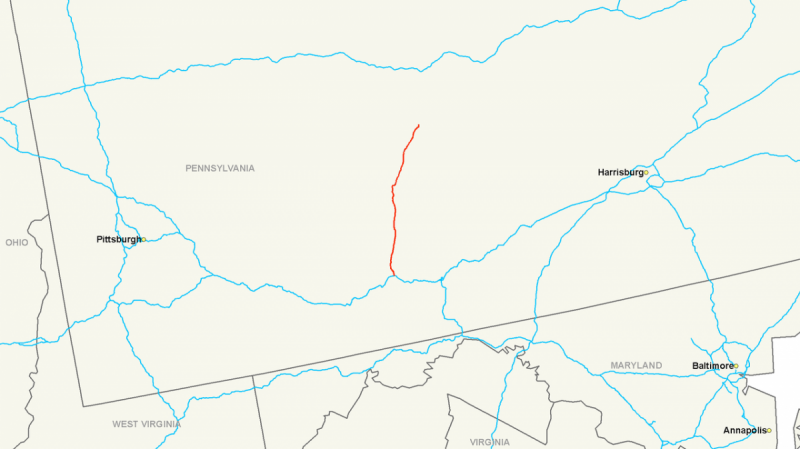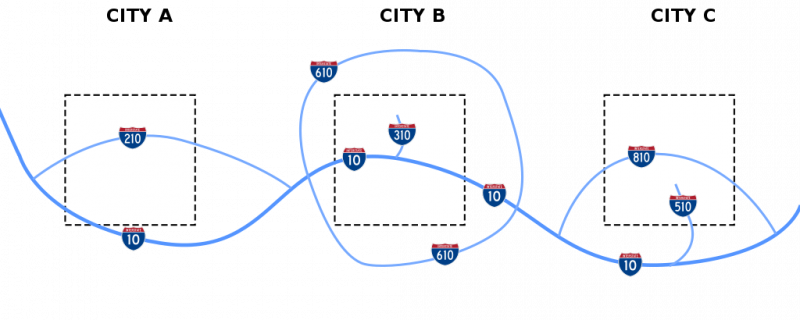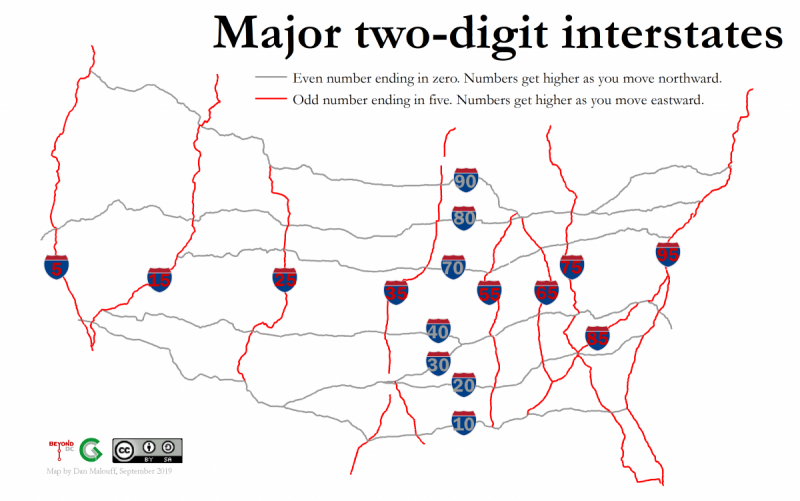Decode the interstates: What highway numbers actually mean

Image by the author.
Why is I-95 named I-95? What about I-395, or I-270, or I-66? There’s a logical system behind it all, and it’s easy to learn.
First, how many digits
The number of digits tells you whether an interstate connects multiple metro areas, or exists solely within a single metro area. One and two-digit interstates span multiple regions, while three-digit interstates are more local. The rest of the system flows from this most basic starting point.
The one/two-digit system
There are three factors that go into determining the number for a two-digit interstate:
- East-west roads get even numbers, while north-south roads get odd.
- The lowest numbers begin in the south and west, and get higher as you progressively move north and east.
- The most important cross-country interstates get numbers divisible by five, meaning they end in zero or five.
Thus, for example, the name I-95 was reserved for the farthest east major national cross-country interstate that traverses a north-south route. Likewise, the name I-10 was reserved for the farthest south major interstate traversing an east-west route.
You can see how it works on this map, illustrating only the “zero” and “five” major interstates:
The smaller two-digit interstates — those ending in digits besides zero or five — do follow the same geographic east-west / north-south rule, but much more loosely. Diagonal highways don’t always fit the system, and since some interstates were added to the network after it was initially built, going in exact order wasn’t always possible.
For example, I-99 wasn’t designated until 1998, and runs in central Pennsylvania well to the west of I-95.
The short and inglorious I-99, shown in red. Public domain image. 
Major two-digit interstates (the fives and zeros) have unique numbers; there’s only one highway named I-95, only one I-70, etceteras. But the smaller two-digiters can repeat as long as they’re far apart from each other. For example, there are separate I-76s in Pennsylvania and Colorado, and separate I-87s in New York and North Carolina.
There are a few very short two-digit interstates that probably should have gotten three-digit numbers instead. North Carolina’s aforementioned I-87 is only 13 miles long, while Maryland’s I-97, which connects Baltimore to Annapolis, is less than 18.
The three-digit system
Three-digit interstates are shorter routes that serve individual metro areas, as opposed to the two-digit intercity routes. They connect to longer two-digit routes, and act as beltways, spurs, or connectors. There are two factors that go into three-digit numbering:
- The latter two digits reflect whatever two-digit interstate the route connects to. For example, I-395 connects to I-95, and I-270 connects to I-70.
- The first digit reflects the purpose of the road. Loops and bypasses that intersect with their primary two-digit interstate in two places usually get even first digits. Spurs and connectors that only intersect once usually get odd first digits.
Three-digit interstate naming system. Public domain image. 
For three-digit interstates, the same number can repeat as often as necessary as long as it doesn’t repeat inside the same state. For example there are seven different I-395s, and four different I-270s. Notice that both Baltimore and Washington have their own spur I-395, but Baltimore doesn’t have an I-495 because Washington’s Beltway enters Maryland.
There are of course numerous exceptions. Maryland’s I-270 is a particular troublemaker: Why should a spur connecting to I-70 at only one location get an even first digit instead of an odd? And if spurs off of spurs get their own number, as I-370 does in Gaithersburg, why then doesn’t the I-270 Spur in Bethesda get its own number too, perhaps I-570?
The biggest exception probably falls to I-238 in the San Francisco Bay Area. There’s no I-38 and thus there should be no I-238. I-238 is a connector between I-580 and I-880, each in turn spurs off of I-80. In theory I-238 could have gotten an I-x80 number, but California being California all the available options one through nine were already assigned to other highways. Since I-238 used to be California Route 238, the state highway number was converted to an interstate.
Hawaii, Alaska, and Puerto Rico
Despite having no direct land connections to the rest of the United States, Hawaii, Alaska, and Puerto Rico all have interstate highways. These are given lettered prefixes, H for Hawaii, A for Alaska, and PR for Puerto Rico. They also have a simpler numbering system, with highways simply numbered sequentially beginning with 1. Hawaii’s first interstate is H1, Alaska’s A1, and Puerto Rico’s PR1.
These can have three-digit spurs, though H201 is the only such example.
Did I miss anything?

